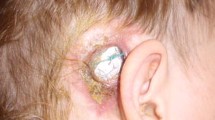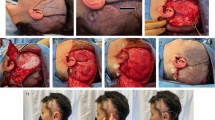Abstract
With an increase in the number of cochlear implant surgeries there is bound to be an increase in the number of complications. A dreaded problem in any implant procedure is the implant exposure and infection. Explantation of the implant leads to an unpleasant situation to the patient and the surgeon owing to the high cost of the device. There are reports in the literature favouring the mandatory relocation or removal of the infected implants. On the other hand, there are convincing reports of implant salvage using skin, muscle or fascial flaps. In this paper we have analysed a series of cases referred to us from the departments of E.N.T for the management of implant exposure/infection. We have also reviewed similar case series reported in the literature. From 2014 to 2017 we operated six cases of exposed cochlear implant. We salvaged the implant in five cases, where we could do two layer coverage consisting of the inner temporoparietal fascial flap and outer scalp skin flap. In one case where the temporoparietal fascial flap could not be done as superficial temporal vessels were found to be injured in the previous surgery, the implant was removed due to persistent infection. All these cases were administered appropriate antibiotics for a minimum period of 3 weeks. Early double layer closure with inner temporoparietal fascial flap and outer scalp rotation flap coupled with appropriate antibiotics can salvage an infected, exposed implant.





Similar content being viewed by others
References
Skrivan J, Drevinek P (2016) A case report of a cochlear implant infection—A reason to explant the device? Cochlear Implants Int 17(5):246–249
Haberkamp TJ, Schwaber MK (1992) Management of flap necrosis in cochlear implantation. Ann Otol Rhinol Laryngol 101(1):38–41
Cunningham CD, Slattery WH, Luxford WM (2004) Postoperative infection in cochlear implant patients. Otolaryngol Head Neck Surg 131(1):109–114
Leach J, Kruger P, Roland P (2005) Rescuing the imperiled cochlear implant: a report of four cases. Otol Neurotol 26(1):27–33
Gluth MB, Singh R, Atlas MD (2011) Prevention and management of cochlear implant infections. Cochlear Implants Int 12(4):223–227
Schierholz JM, Beuth J (2001) Implant infections: a haven for opportunistic bacteria. J Hosp Infect 49(2):87–93
Tan KJ, Lim CT, Lim AY (2010) The use of muscle flaps in the salvage of infected exposed implants for internal fixation. J Bone Jt Surg Br 92(3):401–405
Seo BF, Park SW, Han HH, Moon SH, Oh DY, Rhie JW (2015) Salvaging the exposed cochlear implant. J Craniofac Surg 26(8):749–752
Gawęcki W, Karlik M, Borucki Ł, Szyfter-Harris J, Wróbel M (2016) Skin flap complications after cochlear implantations. Eur Arch Otorhinolaryngol 273(12):4175–4183
Birt BD, Antonyshyn O, Gruss JS (1987) The temporalis muscle flap for head and neck reconstruction. J Otolaryngol 16(3):179–184
Mattingly JK, Greene NT, Jenkins HA, Tollin DJ, Easter JR, Cass SP (2015) Effects of skin thickness on cochlear input signal using transcutaneous bone conduction implants. Otol Neurotol 36(8):1403–1411
Elgandy MS, Mobashir MK, El-Sheikh E, Hansen M, Tyler R, Dunn C, Gantz B (2018) Revision cochlear implant surgery. Int Tinnitus J 22(2):188–197
Odabasi O, Mobley SR, Bolanos RA, Hodges A, Balkany T (2000) Cochlear implantation in patients with compromised healing. Otolaryngol Head Neck Surg 123:738–741
Beckenstein MS, Steenerson RL, Elliott LF, Hartrampf CR (1999) Use of a superficial temporal fascia flap for coverage of an exposed cochlear implant. Otolaryngol Head Neck Surg 120(6):940–942
Limasánchez JS, Berenguer B, Aránguez G, Gonzálezmeli BM, Marín CM, de Tomás P (2013) Extruded cochlear implant magnet covered with a temporoparietal fascial flap. A case report E. Cir Pediatr 26(1):48–51
Karimnejad K, Akhter AS, Walen SG (2017) The temporoparietal fascia flap for coverage of cochlear reimplantation following extrusion. Int J Pediatr Otorhinolaryngol 94:64–67
Jaquet Y, Higgins KM, Enepekides DJ (2011) The temporoparietal fascia flap: a versatile tool in head and neck reconstruction. Curr Opin Otolaryngol Head Neck Surg 19(4):235–241
Funding
This research did not receive any specific grant from funding agencies in the public, commercial, or not-for-profit sectors.
Author information
Authors and Affiliations
Corresponding author
Ethics declarations
Conflict of interest
Authors declare that they have no conflict of interest.
Ethical Approval
As this paper was a case series involving only a modification of an accepted flap design, no specific ethical committee approval was obtained.
Informed Consent
Informed consent was obtained from all the patients. Additional informed consent was obtained from those patients whose identifiable information is included in this article.
Additional information
Publisher's Note
Springer Nature remains neutral with regard to jurisdictional claims in published maps and institutional affiliations.
Rights and permissions
About this article
Cite this article
Hariharan, N.C., Muthukumar, R., Sridhar, R. et al. Ideal Flap Cover for the Salvage of Exposed/Infected Cochlear Implants: A Case Series and Literature Review. Indian J Otolaryngol Head Neck Surg 72, 292–296 (2020). https://doi.org/10.1007/s12070-019-01764-1
Received:
Accepted:
Published:
Issue Date:
DOI: https://doi.org/10.1007/s12070-019-01764-1




